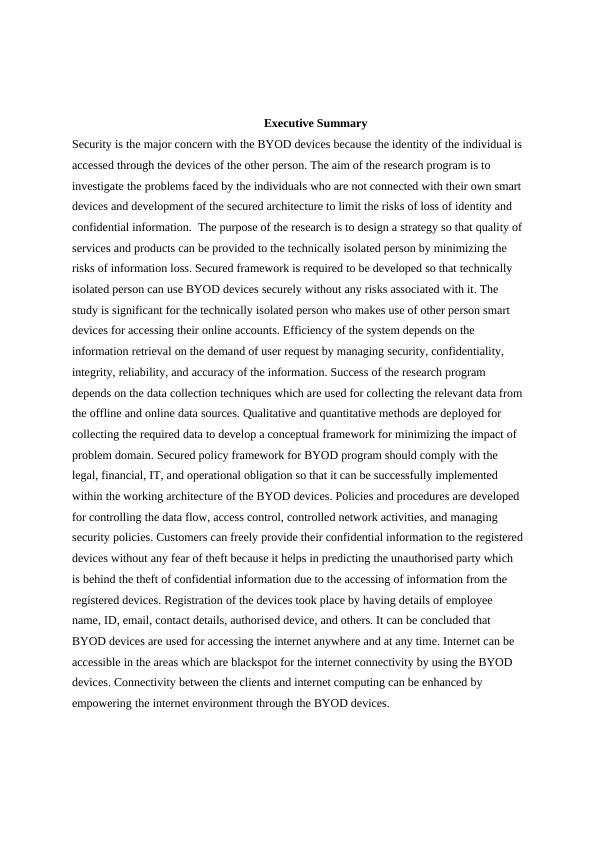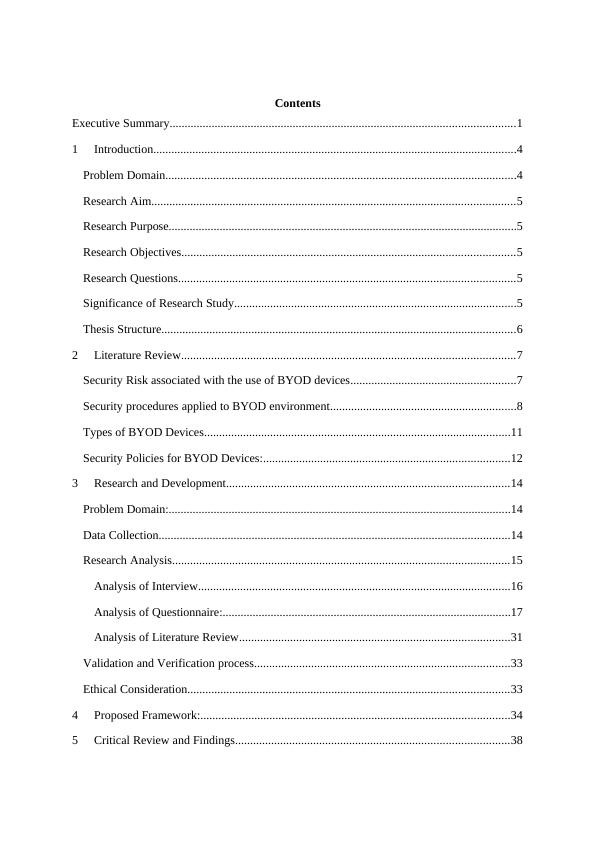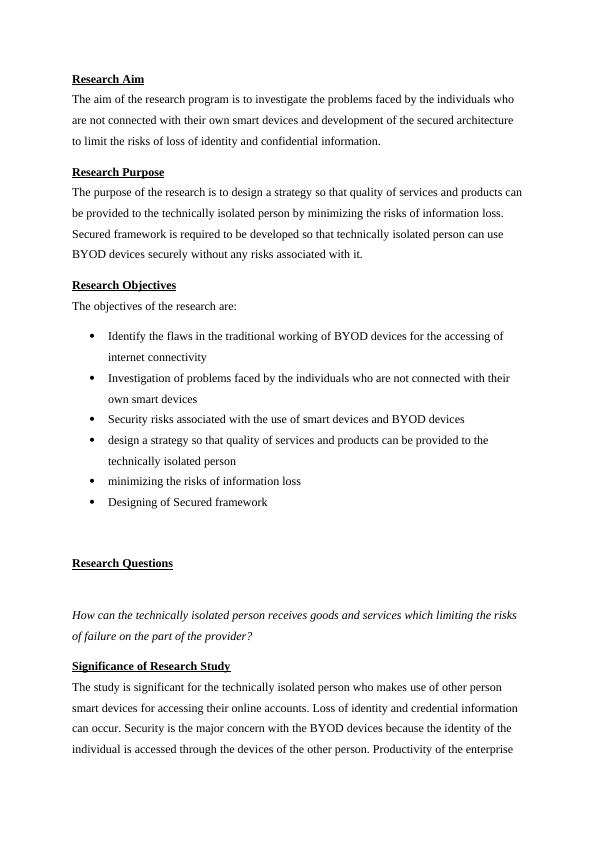Secured Architecture for BYOD Devices
This assignment is about formulating research questions for development projects in the field of computer science. It discusses the importance of making a contribution to knowledge and provides guidance on how to formulate objectives for building software systems as research.
57 Pages13641 Words70 Views
Added on 2022-11-29
About This Document
This dissertation focuses on the problems faced by individuals who are not connected with their own smart devices and the development of a secured architecture to limit the risks of loss of identity and confidential information. It aims to design a strategy to provide quality services and products to technically isolated individuals by minimizing the risks of information loss. The study is significant for technically isolated individuals who use other people's smart devices for accessing their online accounts.
Secured Architecture for BYOD Devices
This assignment is about formulating research questions for development projects in the field of computer science. It discusses the importance of making a contribution to knowledge and provides guidance on how to formulate objectives for building software systems as research.
Added on 2022-11-29
ShareRelated Documents
Dissertation

Executive Summary
Security is the major concern with the BYOD devices because the identity of the individual is
accessed through the devices of the other person. The aim of the research program is to
investigate the problems faced by the individuals who are not connected with their own smart
devices and development of the secured architecture to limit the risks of loss of identity and
confidential information. The purpose of the research is to design a strategy so that quality of
services and products can be provided to the technically isolated person by minimizing the
risks of information loss. Secured framework is required to be developed so that technically
isolated person can use BYOD devices securely without any risks associated with it. The
study is significant for the technically isolated person who makes use of other person smart
devices for accessing their online accounts. Efficiency of the system depends on the
information retrieval on the demand of user request by managing security, confidentiality,
integrity, reliability, and accuracy of the information. Success of the research program
depends on the data collection techniques which are used for collecting the relevant data from
the offline and online data sources. Qualitative and quantitative methods are deployed for
collecting the required data to develop a conceptual framework for minimizing the impact of
problem domain. Secured policy framework for BYOD program should comply with the
legal, financial, IT, and operational obligation so that it can be successfully implemented
within the working architecture of the BYOD devices. Policies and procedures are developed
for controlling the data flow, access control, controlled network activities, and managing
security policies. Customers can freely provide their confidential information to the registered
devices without any fear of theft because it helps in predicting the unauthorised party which
is behind the theft of confidential information due to the accessing of information from the
registered devices. Registration of the devices took place by having details of employee
name, ID, email, contact details, authorised device, and others. It can be concluded that
BYOD devices are used for accessing the internet anywhere and at any time. Internet can be
accessible in the areas which are blackspot for the internet connectivity by using the BYOD
devices. Connectivity between the clients and internet computing can be enhanced by
empowering the internet environment through the BYOD devices.
Security is the major concern with the BYOD devices because the identity of the individual is
accessed through the devices of the other person. The aim of the research program is to
investigate the problems faced by the individuals who are not connected with their own smart
devices and development of the secured architecture to limit the risks of loss of identity and
confidential information. The purpose of the research is to design a strategy so that quality of
services and products can be provided to the technically isolated person by minimizing the
risks of information loss. Secured framework is required to be developed so that technically
isolated person can use BYOD devices securely without any risks associated with it. The
study is significant for the technically isolated person who makes use of other person smart
devices for accessing their online accounts. Efficiency of the system depends on the
information retrieval on the demand of user request by managing security, confidentiality,
integrity, reliability, and accuracy of the information. Success of the research program
depends on the data collection techniques which are used for collecting the relevant data from
the offline and online data sources. Qualitative and quantitative methods are deployed for
collecting the required data to develop a conceptual framework for minimizing the impact of
problem domain. Secured policy framework for BYOD program should comply with the
legal, financial, IT, and operational obligation so that it can be successfully implemented
within the working architecture of the BYOD devices. Policies and procedures are developed
for controlling the data flow, access control, controlled network activities, and managing
security policies. Customers can freely provide their confidential information to the registered
devices without any fear of theft because it helps in predicting the unauthorised party which
is behind the theft of confidential information due to the accessing of information from the
registered devices. Registration of the devices took place by having details of employee
name, ID, email, contact details, authorised device, and others. It can be concluded that
BYOD devices are used for accessing the internet anywhere and at any time. Internet can be
accessible in the areas which are blackspot for the internet connectivity by using the BYOD
devices. Connectivity between the clients and internet computing can be enhanced by
empowering the internet environment through the BYOD devices.


Contents
Executive Summary...................................................................................................................1
1 Introduction.........................................................................................................................4
Problem Domain.....................................................................................................................4
Research Aim.........................................................................................................................5
Research Purpose....................................................................................................................5
Research Objectives...............................................................................................................5
Research Questions................................................................................................................5
Significance of Research Study..............................................................................................5
Thesis Structure......................................................................................................................6
2 Literature Review...............................................................................................................7
Security Risk associated with the use of BYOD devices.......................................................7
Security procedures applied to BYOD environment..............................................................8
Types of BYOD Devices......................................................................................................11
Security Policies for BYOD Devices:..................................................................................12
3 Research and Development..............................................................................................14
Problem Domain:..................................................................................................................14
Data Collection.....................................................................................................................14
Research Analysis................................................................................................................15
Analysis of Interview........................................................................................................16
Analysis of Questionnaire:................................................................................................17
Analysis of Literature Review..........................................................................................31
Validation and Verification process.....................................................................................33
Ethical Consideration...........................................................................................................33
4 Proposed Framework:.......................................................................................................34
5 Critical Review and Findings...........................................................................................38
Executive Summary...................................................................................................................1
1 Introduction.........................................................................................................................4
Problem Domain.....................................................................................................................4
Research Aim.........................................................................................................................5
Research Purpose....................................................................................................................5
Research Objectives...............................................................................................................5
Research Questions................................................................................................................5
Significance of Research Study..............................................................................................5
Thesis Structure......................................................................................................................6
2 Literature Review...............................................................................................................7
Security Risk associated with the use of BYOD devices.......................................................7
Security procedures applied to BYOD environment..............................................................8
Types of BYOD Devices......................................................................................................11
Security Policies for BYOD Devices:..................................................................................12
3 Research and Development..............................................................................................14
Problem Domain:..................................................................................................................14
Data Collection.....................................................................................................................14
Research Analysis................................................................................................................15
Analysis of Interview........................................................................................................16
Analysis of Questionnaire:................................................................................................17
Analysis of Literature Review..........................................................................................31
Validation and Verification process.....................................................................................33
Ethical Consideration...........................................................................................................33
4 Proposed Framework:.......................................................................................................34
5 Critical Review and Findings...........................................................................................38

Implementation process of the proposed secured network for BYOD environment...........41
6 Discussion.........................................................................................................................42
7 Conclusion........................................................................................................................46
8 References.........................................................................................................................48
6 Discussion.........................................................................................................................42
7 Conclusion........................................................................................................................46
8 References.........................................................................................................................48

1 Introduction
With the rapid growth in the technological advancement, dependency over the smart devices
and mobiles phones is accelerated. In today’s era, mobile phones and connectivity with the
smart phones is becoming necessity and basic requirement of the individual. Persons are not
able to get quality of services and delivery of online product if they are not having
connectivity with the internet access. It is difficult for the persons who are living in the
isolated environment where the internet accessing is not possible. Online companies take a
step forward to provide BYOD (Bring your own devices) technology so that courier services
can be provided to the individuals who are not having connectivity with smart devices.
BYOD devices are used for accessing the internet anywhere and at any time. Internet can be
accessible in the areas which are blackspot for the internet connectivity by using the BYOD
devices. Connectivity between the clients and internet computing can be enhanced by
empowering the internet environment through the BYOD devices [1]. Security is the major
concern with the BYOD devices because the identity of the individual is accessed through the
devices of the other person. Information leakages and hacking can occur. For example,
changes and modification can be done in the medical reports, loss of login credential,
information can be accessed by the third party, and others by retrieving information from the
devices brought by the delivery person for the delivery of the product such as digital
signature, and many others [2]. It is required to design a security system which is helpful for
evaluating that the delivery of the product is provided to the right person or not and also the
individual identity information should be kept confidential.
Problem Domain
People who are living in the blackspot areas for the internet accessing is facing problem in
the delivery of the product to the right person at right time. Accessibility of internet
connectivity is not guaranteed and assured so individual face problem in receiving the quality
of service and facilities. To overcome the problem of internet accessibility, BYOD devices
are used by the courier services so that product can be delivered to the authorised person by
verifying their identity. Loss of identity, credential information, digital signature, and others
are the major flaws which are comply with the identity checks through the smart devices of
other person.
With the rapid growth in the technological advancement, dependency over the smart devices
and mobiles phones is accelerated. In today’s era, mobile phones and connectivity with the
smart phones is becoming necessity and basic requirement of the individual. Persons are not
able to get quality of services and delivery of online product if they are not having
connectivity with the internet access. It is difficult for the persons who are living in the
isolated environment where the internet accessing is not possible. Online companies take a
step forward to provide BYOD (Bring your own devices) technology so that courier services
can be provided to the individuals who are not having connectivity with smart devices.
BYOD devices are used for accessing the internet anywhere and at any time. Internet can be
accessible in the areas which are blackspot for the internet connectivity by using the BYOD
devices. Connectivity between the clients and internet computing can be enhanced by
empowering the internet environment through the BYOD devices [1]. Security is the major
concern with the BYOD devices because the identity of the individual is accessed through the
devices of the other person. Information leakages and hacking can occur. For example,
changes and modification can be done in the medical reports, loss of login credential,
information can be accessed by the third party, and others by retrieving information from the
devices brought by the delivery person for the delivery of the product such as digital
signature, and many others [2]. It is required to design a security system which is helpful for
evaluating that the delivery of the product is provided to the right person or not and also the
individual identity information should be kept confidential.
Problem Domain
People who are living in the blackspot areas for the internet accessing is facing problem in
the delivery of the product to the right person at right time. Accessibility of internet
connectivity is not guaranteed and assured so individual face problem in receiving the quality
of service and facilities. To overcome the problem of internet accessibility, BYOD devices
are used by the courier services so that product can be delivered to the authorised person by
verifying their identity. Loss of identity, credential information, digital signature, and others
are the major flaws which are comply with the identity checks through the smart devices of
other person.

Research Aim
The aim of the research program is to investigate the problems faced by the individuals who
are not connected with their own smart devices and development of the secured architecture
to limit the risks of loss of identity and confidential information.
Research Purpose
The purpose of the research is to design a strategy so that quality of services and products can
be provided to the technically isolated person by minimizing the risks of information loss.
Secured framework is required to be developed so that technically isolated person can use
BYOD devices securely without any risks associated with it.
Research Objectives
The objectives of the research are:
Identify the flaws in the traditional working of BYOD devices for the accessing of
internet connectivity
Investigation of problems faced by the individuals who are not connected with their
own smart devices
Security risks associated with the use of smart devices and BYOD devices
design a strategy so that quality of services and products can be provided to the
technically isolated person
minimizing the risks of information loss
Designing of Secured framework
Research Questions
How can the technically isolated person receives goods and services which limiting the risks
of failure on the part of the provider?
Significance of Research Study
The study is significant for the technically isolated person who makes use of other person
smart devices for accessing their online accounts. Loss of identity and credential information
can occur. Security is the major concern with the BYOD devices because the identity of the
individual is accessed through the devices of the other person. Productivity of the enterprise
The aim of the research program is to investigate the problems faced by the individuals who
are not connected with their own smart devices and development of the secured architecture
to limit the risks of loss of identity and confidential information.
Research Purpose
The purpose of the research is to design a strategy so that quality of services and products can
be provided to the technically isolated person by minimizing the risks of information loss.
Secured framework is required to be developed so that technically isolated person can use
BYOD devices securely without any risks associated with it.
Research Objectives
The objectives of the research are:
Identify the flaws in the traditional working of BYOD devices for the accessing of
internet connectivity
Investigation of problems faced by the individuals who are not connected with their
own smart devices
Security risks associated with the use of smart devices and BYOD devices
design a strategy so that quality of services and products can be provided to the
technically isolated person
minimizing the risks of information loss
Designing of Secured framework
Research Questions
How can the technically isolated person receives goods and services which limiting the risks
of failure on the part of the provider?
Significance of Research Study
The study is significant for the technically isolated person who makes use of other person
smart devices for accessing their online accounts. Loss of identity and credential information
can occur. Security is the major concern with the BYOD devices because the identity of the
individual is accessed through the devices of the other person. Productivity of the enterprise

gets enhanced by improving the level of satisfaction of the customer by fulfilling their
requirement of internet connectivity. Security is the major concern with the use of BYOD
devices because it can results into accessing of confidential information of the user by the
third party. Unsecured Wi-Fi is accessed by the user for receiving goods and services at the
blackspot areas for internet connectivity. The project is designed for providing security and
reliability to the accessing of information from the unsecured network.
Thesis Structure
In the first chapter of the dissertation, focus is given on introduction and the problem faced
by the people who are living in the Blackspot internet connectivity areas. Research question
is designed to give the direction to the research so that relevant and accurate data can be
collected from the public domain through the organization of interview and questionnaire
sessions.
Second chapter gives the details of the findings and research work presented by the different
researchers in their research work. Evaluation of the literature review facts helps in verifying
the output of our research by comparing with the gaps in the research work of the literature
papers.
Third Chapter highlights the research methodology which is conducted for collecting data
from the primary and secondary sources so that relevant and reliable facts and figures can be
gathered.
In the fourth chapter, findings of the undertaken project are proposed with the result drawn
from the research program.
In the fifth chapter focus in given on conclusion drawn from the research to summarise the
research work in concise format.
requirement of internet connectivity. Security is the major concern with the use of BYOD
devices because it can results into accessing of confidential information of the user by the
third party. Unsecured Wi-Fi is accessed by the user for receiving goods and services at the
blackspot areas for internet connectivity. The project is designed for providing security and
reliability to the accessing of information from the unsecured network.
Thesis Structure
In the first chapter of the dissertation, focus is given on introduction and the problem faced
by the people who are living in the Blackspot internet connectivity areas. Research question
is designed to give the direction to the research so that relevant and accurate data can be
collected from the public domain through the organization of interview and questionnaire
sessions.
Second chapter gives the details of the findings and research work presented by the different
researchers in their research work. Evaluation of the literature review facts helps in verifying
the output of our research by comparing with the gaps in the research work of the literature
papers.
Third Chapter highlights the research methodology which is conducted for collecting data
from the primary and secondary sources so that relevant and reliable facts and figures can be
gathered.
In the fourth chapter, findings of the undertaken project are proposed with the result drawn
from the research program.
In the fifth chapter focus in given on conclusion drawn from the research to summarise the
research work in concise format.

End of preview
Want to access all the pages? Upload your documents or become a member.
Related Documents
BYOD Risk Assessment Task 1: Critical Components 2 2 Cyber Security Name of University Authorlg...
|15
|2429
|149
Risk Assessment: BYOD Policylg...
|14
|4528
|331
Cybersecurity: BYOD Risk Assessment, Certificate-based Authentication, Anti-phishing Guidelinelg...
|10
|2414
|209
Solutions of Cybersecurity Assignmentlg...
|9
|2005
|320
Challenges for BYOD in IT Networklg...
|6
|934
|283
Why is cybersecurity important for the education sector?lg...
|14
|3669
|11
